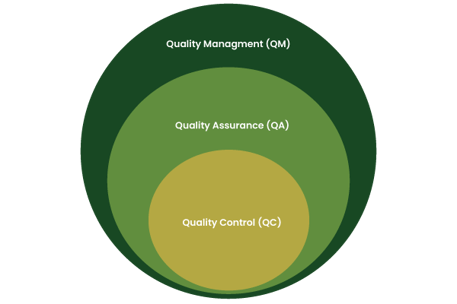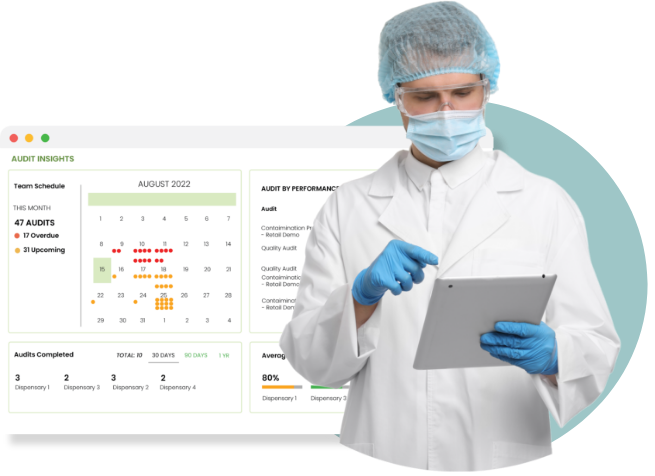Author: Ben Hartman | May 16, 2022 | 6 Min Read
What is Quality Assurance in Cannabis?

Mold, heavy metals, bacteria, pesticides - the hazards that can arise in cannabis are by no means limited to traffic stops and pre-employment drug screening. For consumers, the presence of contaminants in cannabis products can lead to unpleasant user experiences and, in some cases, potentially dangerous health complications.
For cannabis product manufacturers, these hazards can result in product recalls, product liability lawsuits, and irreversible damage to their company's reputation.
To ensure the safety of cannabis products, manufacturers create quality management systems based upon clearly-defined quality assurance and quality control protocols.
What’s the Difference Between Quality Assurance and Quality Control?
Often confused with one another, quality assurance and quality control are two distinct processes in quality management.

According to the American Society for Quality, “quality assurance activities and responsibilities cover virtually all of the quality system in one fashion or another, while QC [quality control] is a subset of the QA activities.”
What is Quality Assurance?
According to the ASQ, quality assurance is the part of quality management “focused on providing confidence that quality requirements will be fulfilled."
The ASQ states that this entails the “planned and systematic activities implemented within the quality system that can be demonstrated to provide confidence that a product or service will fulfill requirements for quality."
What is Quality Control?
The ASQ writes that “while quality assurance relates to how a process is performed or how a product is made, quality control is more the inspection aspect of quality management. An alternate definition is "the operational techniques and activities used to fulfill requirements for quality."
Consider the difference: Quality assurance is more preventative and is meant to define the processes and standards that need to be carried out during the production process to ensure products will meet quality requirements. Quality control focuses on monitoring activities meant to identify defects or shortcomings in the production process and implement corrective actions to eliminate or mitigate the issue to an acceptable level.
But quality controls should be distinct from safety controls, which are processes and systems to reduce safety risks instead of ensuring quality.
The principles of quality management
QA and QC are part of the quality management systems companies and organizations use to improve quality. The most commonly-used standard for these systems is ISO 9001:2015, which includes several generic requirements that can apply to any organization.
The quality management principles are:
- Customer focus
- Leadership
- engagement of people
- process approach
- improvement
- evidence-based decision making
- relationship management
What is quality assurance in cannabis?
A 2021 study on quality assurance and quality management in cannabis in Canada described QC and QA standards as “a key safety feature that can enable informed purchasing and provide consumers with necessary information about various cannabis products.”
For cannabis manufacturers, these methods are also essential to ensuring that potentially harmful contaminants do not make their way into the products they sell.
In an article for Food Safety, Mike Hennesy, the Director of Innovation for Wana Brands, stated that quality assurance is “also an integral piece of your plan, monitoring your operations for product issues like microbial, mold, ingredient degradation, and expiration. When working with ingredients derived from cannabis, you also want to monitor for pesticides and heavy metals. Both CBD and THC products share these concerns.”
Failure to adhere to these quality assurance measures can result in potentially devastating product liability claims against cannabis companies. This is especially true in the case of contaminants like mold, which can potentially pose a severe health risk to consumers with compromised immune systems.
For cannabis companies, while adhering to quality assurance measures may sometimes be a painstaking process, it is still far less painful than having to enact a product recall - much less contend with a product liability lawsuit.
Risk assessment as part of quality management
In cannabis and other industries, risk assessments are necessary for improving safety and achieving company objectives.
According to the American Society of Safety Professionals, risk assessment has three main components: risk identification, analysis, and evaluation. By adequately carrying out these three components, companies can better prioritize their actions to prevent risk and safeguard their employees' and customers' health and safety.
In a 2015 paper by Deloitte and the Manufacturers Alliance for Productivity and Innovation (MAPI), the authors wrote that “embedding risk management practices throughout the organization makes identifying and responding to vulnerabilities part of the business culture. Based on an organization’s unique circumstances, current practices should be challenged to determine whether there are more efficient or complete ways to gather risk information to enhance the periodic assessment.”
These risk assessment measures can also help play a key role in ensuring the safe and controlled handling of hazardous chemicals and other materials, helping keep them out of the products that a company’s customers consume.
Enacting HACCP in Cannabis
An essential step in quality assurance and risk management in cannabis is implementing a Hazard Analysis and Critical Control Points (HACCP) plan.
According to the US Food and Drug Administration, HACCP is “a management system in which food safety is addressed through the analysis and control of biological, chemical, and physical hazards from raw material production, procurement, and handling, to manufacturing, distribution, and consumption of the finished product.”
The FDA states that “preventing problems from occurring is the paramount goal underlying any HACCP system” and lists seven basic principles for developing a HACCP system:
- Hazard analysis
- Critical Control Points Identification
- Establishing critical limits
- Monitoring procedures
- Corrective actions
- Verification procedures
- Record-keeping and documentation
But just as the HACCP process can ensure food safety, it can do the same for cannabis products.
As Jill Ellsworth wrote in a post on Food Safety Tech, “It’s high time for the cannabis industry to adopt FDA-like standards and proactively promote safety measures. Cannabis growers must implement these quality controls to ensure that their products are as safe to consume as any other food or drink on the market.”
End-to-End quality assurance in cannabis
To ensure the quality and safety of cannabis products, manufacturers must make these preventative and corrective actions part of the entire seed-to-shelf process.
Cannabis manufacturers must develop standard operating procedures (SOPs) that cover such processes as:
- Facility maintenance and cleaning
- Disinfectants and cleaning agents
- Identifying hazardous chemicals
- Employee sanitation and health
- Storage and transfer procedures
- Waste management
- Chemical and hazardous waste
But that’s barely scratching the surface.
Beyond formulating such procedures, cannabis companies must also make their application a team effort central to their team's day-to-day operations. Companies must make these measures an integral part of each employee’s responsibilities. By reinforcing, assessing, and evaluating adherence to these responsibilities, companies can build a culture of quality assurance in the workplace.
The result is safer cannabis products and companies more likely to meet the industry's safety, compliance, and quality demands.
Contributors

Ben Hartman
From HACCP certification to the basics of hygiene, our on-demand courseware has you covered.





.jpg?width=120&height=80&name=Baby%20(1).jpg)

